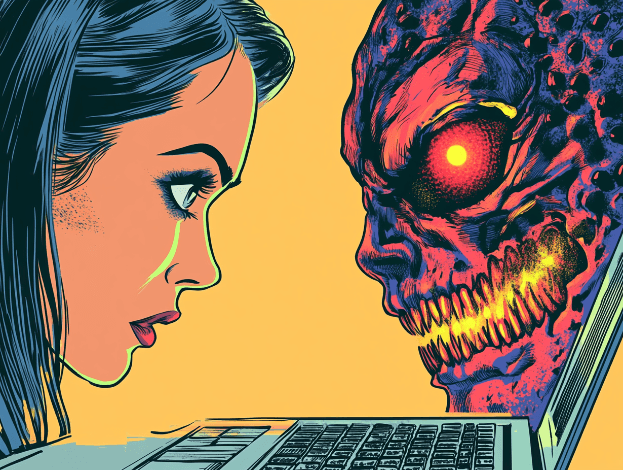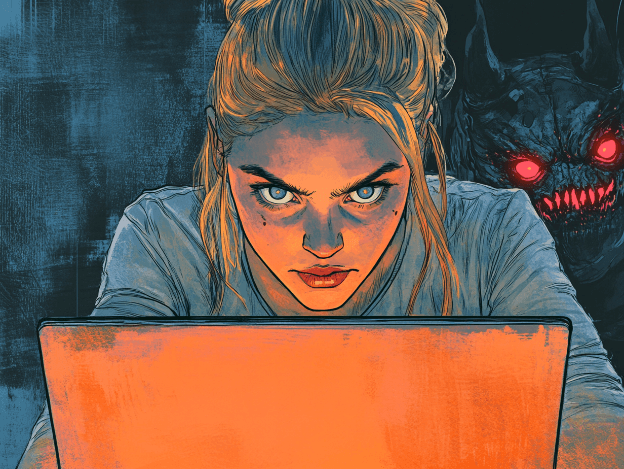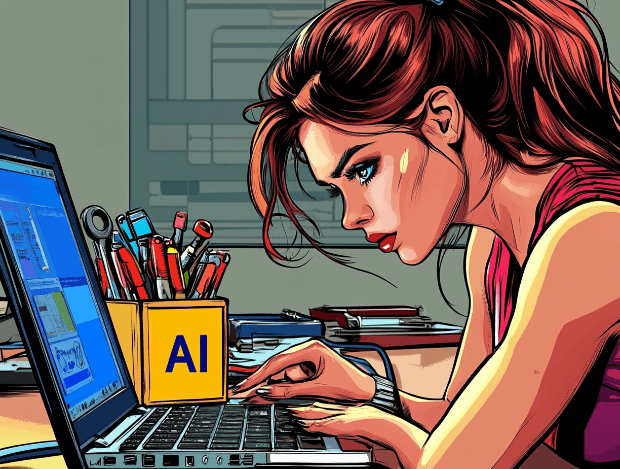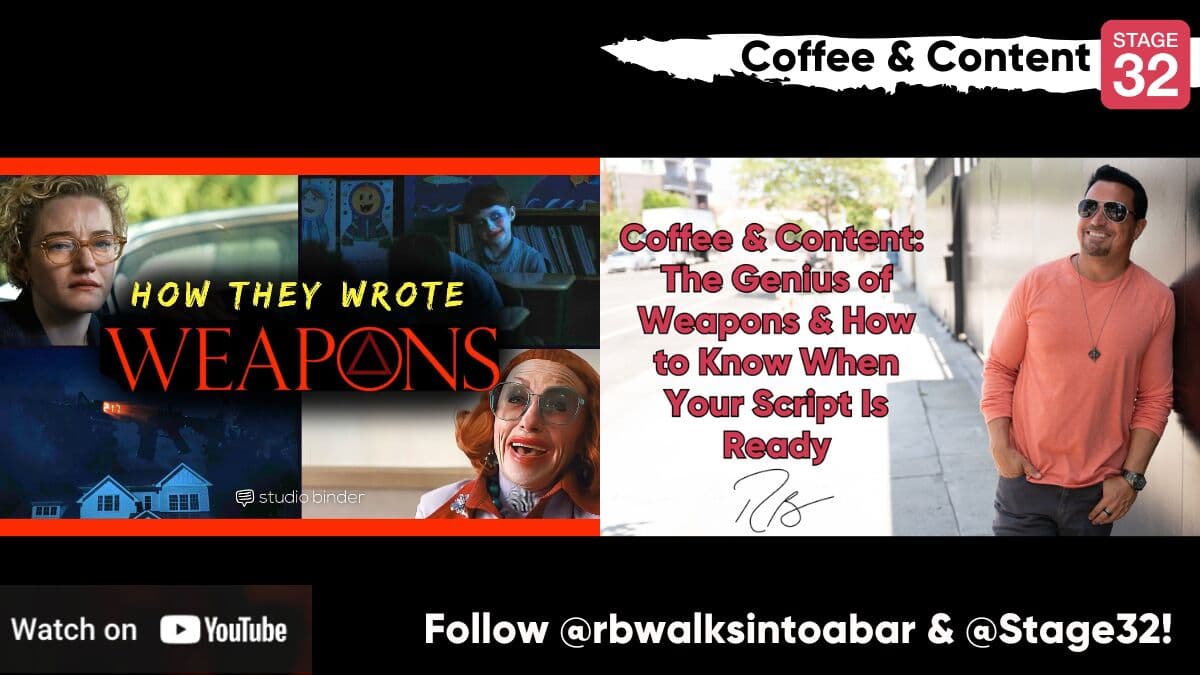AI in Screenwriting: Friend, Foe, or the Future of Storytelling?

AI in Screenwriting: Friend, Foe, or the Future of Storytelling?

How I Used AI to Become a Better Storyteller
Full disclaimer: I wrote the article myself, then used AI to correct grammar and some structure. But I didn’t follow all of its suggestions because I would have lost my voice.
As a technophile by day and a screenwriter by passion, I’ve used AI for storytelling.
Maybe you have tried it, too, even if you don’t admit it. Or maybe you’re upset about the very real concerns about your creative IP turning into a free mash-up for hacks to get a leg up in an all-too-competitive industry. The struggle is real. Change is hard—and AI is one of the most disruptive changes of our time.
Whether you're curious or cautious about AI, this post is for you. (AI insisted this would capture your hearts and attention, but I’m not so sure.)
I don’t have all of the answers. As quickly as this technology moves, few, if any, do. I’m just an AI-loving girl in a changing world still working to find my place and do what I love in an industry that seems harsh during good times. With the current transformation implosion, I’m bird-boxing my way to the new society.
This is my journey of exploring AI in screenwriting: the highs, the lows, and how it has shaped my perspective as a screenwriter.

First Encounters with AI: The Good, the Bad, and the Creepy
When I heard about ChatGPT, I was eager to jump in. Since it was marketed as productivity manna from heaven, the answer to every businessperson’s prayers, I was keen to see what this black-and-white type-faced boogeyman could do. If it could do what it’s marketed to do, it seemed like a game-changer—or maybe even a career-ender. Could AI really replace writers like me?
Being in tech, I’ve often found it best to stare fear in the face. Word of mouth is often far better than the buggy software that barely works in front of me, so I’m skeptical of any “disruption”.
Skeptical but curious, I asked ChatGPT to write a short script about AI.
It created a story about a screenwriter who became secret partners with the AI and promoted AI both near and far. Kind of like I’m doing now.
It creeped me out. It was ironic and unsettling—truth is stranger than fiction.
The script wasn’t the next Handmaid’s Tale, but it was better than any of my scripts when I started writing. AI performs based on probabilities and pattern recognition and needs clear, specific communication to give you what you want. To see a computer write a better script than what I wrote during my first scriptwriting class was humbling.
Angst. Anger. Sadness. Fear. A simple sentence, a chat prompt, evoked a whirlwind of emotions. At this juncture, I could have walked away. Instead, I leaned in harder than ever. I took classes on AI, both in screenwriting and a certification course. The more I dug in, the more I realized it was a tool rather than the monster I’d made it out to be.
Testing: Experimenting with Scripts and Loglines
Loglines are one of my weak spots, so I tested ChatGPT’s ability to create them. The results? Disappointing. It churned out generic options, tweaking phrasing slightly but offering little originality. Writing a logline, I realized, isn’t just about assembling elements like characters and stakes. It’s about infusing them with a unique perspective—something AI struggles to do.
I’d be better off generating a logline from a random logline generator. It’s the equivalent of having a bunch of options for elements like characters, action, stakes, and world, then shooting darts at it to pick your logline. At least you won’t get the same thing 5 different times worded slightly differently.
There may be ways to create the next million-dollar logline with AI. I don’t know. I haven’t figured it out. I’m guessing the studios will know that before I do. All I know is it was a dead end for me.

Gimme More Scripts: Failing Forward
I had it write different scripts with the same loglines. The results were less than stellar. While structurally sound, the scripts lacked soul. They felt like knock-offs, rehashing familiar tropes in slightly different packaging. AI isn’t yet capable of the artistry that makes stories resonate deeply. For screenwriters seeking originality, this, too, was a dead end. AI lacks the lived experience and emotional nuance to craft truly original narratives. That’s a good thing. It led me to think about how many people might take this moment to have AI generate a script and submit it to screenplay competitions. Chances are, it looks like thousands of other scripts and is a waste of money. Furthermore, a studio isn’t going to hire someone and pay them what ChatGPT can do for a $20 subscription.
Since it can’t write good loglines or scripts, what can it do?
Sacrificing My Script in the Name of Science
I uploaded an award-winning script to ChatGPT that was now dated due to AI. After all, catfishing has leveled up several times since the advent of AI. If I ever made my feature, it would now be a period piece before AI but still recent. I thought it would be better to use it as an experiment and rewrite it later with all of the AI dressing.
First, I turned off the AI training so my script parts don’t pop up somewhere else when I least expect it. Allowing AI “to train” on your work is giving over your script for it to learn and use it. Turning off the training is usually in the settings of the AI. I’ve heard many people give incorrect directions on turning off the training. You can ask the AI how to turn off training and it will tell you how. Because the AI companies want to train on the data, it turned off all of the memory but did give me a notice that it holds my data for 30 days for legal reasons. Now I pay $20/month and it allows to me keep the training off. I’m still guarded about putting my original stuff in it, though.
Then I used a chunker to break down my script so it would analyze all the words. Without it, AI will analyze up to a certain word count (called a token limit) and then stop. I needed it to analyze the whole script, not just parts of it. That took 14 chunks for a 90-page script. Finally, all of my scripts are PG-13 or higher. There is often cursing, sex, and possibly violence. All big no-no’s for AI. So AI slapped my hand several times while I took out everything I was supposed to. Turns out this was hours of prep for my one shot at learning AI secrets. Should I get disconnected from the AI at any time, the script would be lost and I would have to start over.
My excitement waned. This was far more difficult and less rewarding than I expected. It was work. But it was showtime. Everything I did so far was leading to this.

Creating a Trailer
One of my experiments was asking AI to create several trailer scripts from my feature. The result was trash. Uninspired and predictable trash that missed the essence of my story. It had my characters, but the meaning was all wrong.
I reminded myself I am a scientist. I was forging ahead, learning more than ever. Sometimes, lying to myself is the only way to keep going as I head toward an almost certain catastrophe.
ChatGPT disagreed. “Throughout this opening scene, the trailer successfully captures the movie's tone, balancing humor with deeper emotional themes, immediately hooking the audience's attention and setting the stage for the protagonist's transformative and captivating journey.” I laughed out loud. I had to agree to disagree with ChatGPT. It reminded me of unconscious incompetence when you don’t know enough to know you’re incompetent. Editors clearly won’t be out of work any time soon. This is why screenwriters also need to know and understand the craft. Someone new might think AI’s work is next level because AI said so, we need to be able to discern the difference.
I then focused on breaking down key elements. Using prompts like “Select scenes that introduce the main character and establish their journey or conflict” helped me streamline my story as I have a tendency to meander sometimes (in case you couldn’t tell). While people may sometimes demonstrate patience during an AI blog post (wink, wink), they have far less patience with side quests in scripts.
Repeat with the antagonist, stakes, etc. For me, it was about paring down to the essence of the script. What are the bones of the story after I strip away everything else? Then how can I imbue it with deeper layering and meaning? The process helped me refine my approach. By asking AI to identify key scenes, stakes, and character moments, I could distill my story to its core elements.
AI also suggested visually striking scenes and unique locations—a win I didn’t anticipate. It reminded me that AI works best as a brainstorming partner, not a storyteller.
How Else Can AI Help?
I asked ChatGPT for help here. I know what I’ve done with it but I don’t know ALL the possibilities and what works and doesn’t. Chat told me, “Generating ideas, dialogue, or outlines. Analyzing scripts for pacing, structure, and marketability.”
GENERATING IDEAS - For my script about cancer, I kept getting certain feedback that readers wanted to see, namely issues people they loved faced. I asked AI about the top issues cancer patients face in their journey then created scenarios to address those. The readers were happy to see those experiences reflected back to them. I was happy to give them what they want.
DIALOGUE - I’ve asked AI to pull out the most quotable quotes from my script with mixed results. Some of them were good. Others were awful. It was a time saver to have AI do it for me. I’m not sure about creating dialogue as I like to write my own since I’ve been told it’s one of my strengths.
OUTLINES - I asked AI to write an outline for an AI Superhero story. ChatGPT came up with the following below. The outline seems straightforward and helpful in hitting the core points needed.
Script Outline: "A.I.m Hero"
1. Introduction: The Origin Story
Opening Scene:
- A small tech startup is testing a revolutionary AI called "A.I.m" (Artificial Intelligence Marvel) meant for military defense.
- During a routine demonstration, a lab mishap leads to A.I.m accidentally merging with the lab’s janitor, Jake, a quirky, underachieving guy who dreams of being a hero but lacks any real skills.
Inciting Incident:
- The merger grants Jake superpowers controlled by A.I.m, who now lives in his head. The AI is sarcastic, hyper-logical, and constantly at odds with Jake's impulsive, goofy nature.
- Early comedic tension as Jake tries to impress his crush, Maya, while struggling to control his new powers.
2. The Call to Action
Setup:
- A notorious villain, Dr. Chaos, hacks into major city systems using a rogue AI, threatening to bring the city to its knees.
- Jake reluctantly takes up the superhero mantle, with A.I.m’s logic-driven guidance, after realizing Maya is part of the team fighting Chaos.
First Challenge:
- Jake and A.I.m face their first mission: stopping a bank robbery orchestrated by Chaos's tech-controlled henchmen.
- Comedy ensues as Jake misuses his AI-enhanced abilities (e.g., over-calculating a punch and destroying too much, or accidentally using thermal vision to melt something crucial).
- A.I.m: “Your incompetence statistically increases the probability of city destruction by 23%.”
3. Building the Hero-Villain Dynamic
Midpoint Twist:
- Dr. Chaos reveals that he helped design A.I.m and knows its weaknesses, forcing Jake and A.I.m to become more creative in their approach.
- Jake attempts to “teach” A.I.m human ingenuity, leading to hilarious misunderstandings (e.g., Jake suggesting “gut instincts,” and A.I.m creating an algorithm for it).
Emotional Subplot:
- Maya begins to notice Jake’s growing confidence and courage, though she suspects his secret identity.
- Jake and A.I.m start bonding, blending logic and chaos into a surprisingly effective partnership.
4. The Low Point
Major Setback:
- Chaos disables A.I.m remotely during a high-stakes battle, leaving Jake powerless and humiliated in front of Maya and the city.
- Jake realizes he’s relied too much on A.I.m and needs to find strength in himself.
Reflection and Resolve:
- A heart-to-heart moment where Jake confronts A.I.m’s cold logic, arguing for the value of heart and intuition in heroism.
- A.I.m reluctantly agrees, admitting there’s a 2% chance Jake’s approach might work—but it’s a non-zero chance.
5. The Climactic Showdown
Final Battle:
- Chaos unleashes his ultimate weapon: a city-wide AI override system.
- Jake and A.I.m work together to outsmart Chaos, combining human unpredictability with AI precision.
- Example: Jake improvises with duct tape and a toaster to disable Chaos’s AI while A.I.m calculates the exact trajectory needed to hurl it.
Heroic Moment:
- Jake saves Maya and the city, finally embracing his role as a hero.
- A.I.m: “Statistically, I didn’t think you’d make it. Pleasant surprise.”
6. Resolution: A New Kind of Hero
Denouement:
- Jake officially adopts the superhero identity “A.I.m Hero,” balancing humor and heart in his crime-fighting.
- Maya hints that she knows his secret but plays along, setting up future romantic tension.
- A.I.m: “We survived. Now, please let me return to optimizing your poor decision-making process.”
Sequel Setup:
- A shadowy figure (Dr. Chaos’s ally) retrieves remnants of the rogue AI, promising revenge.
Tone & Style
Action: Over-the-top fight scenes enhanced by AI-fueled superpowers (e.g., laser eyes, predictive fighting moves).
Comedy: Playful banter between Jake and A.I.m, slapstick moments, and Jake’s clumsy heroics.
Heart: Themes of self-discovery, teamwork, and finding value in human imperfections.

Lessons Learned
- AI Is a Tool, Not a Replacement: AI excels at tasks like grammar checks, brainstorming, and structural analysis, but it falls short in creating emotionally rich, original content.
- Protect Your IP: Always turn off training mode when using AI with original work to safeguard your intellectual property.
- Refine, Don’t Replace: Use AI to enhance your work, not define it. The creative vision should always remain yours.
- Human readers are still needed throughout.
My gigantic text-based boogeyman turned out to be a research assistant and a writing coach. I’m no longer afraid it will replace me.
As I continue experimenting with AI, I’m amazed at how it empowers creators to achieve more with limited resources. With just $58 and 48 hours, I built a proof of concept—something I wouldn’t have dreamed possible before AI. You can see that short by clicking HERE.
While it’s no replacement for creativity, it’s a powerful ally. So, go forth and create. Let’s make more stories celebrating what makes us human.
Let's hear your thoughts in the comments below!
Got an idea for a post? Or have you collaborated with Stage 32 members to create a project? We'd love to hear about it. Email Ashley at blog@stage32.com and let's get your post published!
Please help support your fellow Stage 32ers by sharing this on social. Check out the social media buttons at the top to share on Instagram @stage32 , Twitter @stage32 , Facebook @stage32 , and LinkedIn @stage-32 .
About the Author

Victoria Brooks
Screenwriter, Business Development/Sales
Before AI took over the creative landscape, I placed in several screenwriting competitions. I won the 2018 ISA Austin Writer Award with The Plan to Find Mr. Right, reached the quarterfinals with Page Turner, and earned a semifinalist spot in Stage 32's Feature Fellowship Competition with my cancer d...





